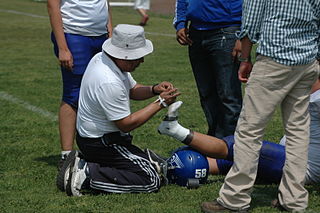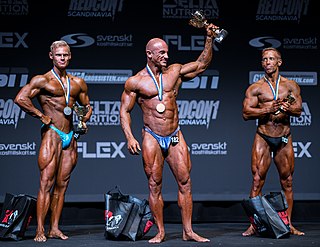
Sports injuries are injuries that occur during sport, athletic activities, or exercising. In the United States, there are approximately 30 million teenagers and children who participate in some form of organized sport. Of those, about three million athletes age 14 years and under experience a sports injury annually. According to a study performed at Stanford University, 21 percent of the injuries observed in elite college athletes caused the athlete to miss at least one day of sport, and approximately 77 percent of these injuries involved the knee, lower leg, ankle, or foot. In addition to those sport injuries, the leading cause of death related to sports injuries is traumatic head or neck occurrences.

Strength training, also known as weight training or resistance training, involves the performance of physical exercises that are designed to improve strength and endurance. It is often associated with the lifting of weights. It can also incorporate a variety of training techniques such as bodyweight exercises, isometrics, and plyometrics.

Plyometrics, also known as jump training or plyos, are exercises in which muscles exert maximum force in short intervals of time, with the goal of increasing power (speed-strength). This training focuses on learning to move from a muscle extension to a contraction in a rapid or "explosive" manner, such as in specialized repeated jumping. Plyometrics are primarily used by athletes, especially martial artists, sprinters and high jumpers, to improve performance, and are used in the fitness field to a much lesser degree.

A vertical jump or vertical leap is the act of jumping upwards into the air. It can be an exercise for building both endurance and strength, and is also a standard test for measuring athletic performance. It may also be referred to as a Sargent jump, named for Dudley Allen Sargent.
General Physical Preparation, also known as GPP, lays the groundwork for later Specific Physical Preparation, or SPP. In the GPP phase, athletes work on general conditioning to improve strength, speed, endurance, flexibility, structure and skill. GPP is generally performed in the off-season, with a lower level of GPP-maintenance during the season, when SPP is being pursued. GPP helps prevent imbalances and boredom with both specific and non-specific exercises by conditioning the body to work.

Progressive overload is a method of strength training and hypertrophy training that advocates for the gradual increase of the stress placed upon the musculoskeletal and nervous system. The principle of progressive overload suggests that the continual increase in the total workload during training sessions will stimulate muscle growth and strength gain by muscle hypertrophy. This improvement in overall performance will, in turn, allow the athlete to keep increasing the intensity of their training sessions.

Endurance training is the act of exercising to increase endurance. The term endurance training generally refers to training the aerobic system as opposed to the anaerobic system. The need for endurance in sports is often predicated as the need of cardiovascular and simple muscular endurance, but the issue of endurance is far more complex. Endurance can be divided into two categories including: general endurance and specific endurance. It can be shown that endurance in sport is closely tied to the execution of skill and technique. A well conditioned athlete can be defined as, the athlete who executes his or her technique consistently and effectively with the least effort. Key for measuring endurance are heart rate, power in cycling and pace in running.

Relative energy deficiency in sport (RED-S) is a syndrome in which disordered eating, amenorrhoea/oligomenorrhoea, and decreased bone mineral density are present. It is caused by eating too little food to support the amount of energy being expended by an athlete, often at the urging of a coach or other authority figure who believes that athletes are more likely to win competitions when they have an extremely lean body type. RED-S is a serious illness with lifelong health consequences and can potentially be fatal.

In sports science theory, supercompensation refers to the post-training period during which the trained parameter has a higher performance capacity than it did prior to the training period.

A training camp is an organized period in which military personnel or athletes participate in a rigorous and focused schedule of training in order to learn or improve skills. Athletes typically utilise training camps to prepare for upcoming events, and in competitive sports, to focus on developing skills and strategies to defeat their opponents. A military training camp generally refers to the period of boot camp, or further or refresher training.

The UPMC Rooney Sports Complex is a multipurpose, multisport training, sports science, and sports medical complex of the University of Pittsburgh Medical Center. The complex is located along the shore of the Monongahela River in Pittsburgh, Pennsylvania, and is unique in that it is the only facility in the United States housing the practice and training facilities for both a collegiate National Collegiate Athletic Association (NCAA) football team and a professional National Football League (NFL) team, the Pittsburgh Panthers and Pittsburgh Steelers respectively. It is also unique in that it combines these training facilities in one location with an academically based sports science and medicine program. The complex consists of four centers which include the Center for Sports Medicine, Sports Training Center, Indoor Training Center, and the Fitness and Conditioning Center located in three buildings along with four outdoor practice fields all situated on 40 acres (16 ha) of land. The UPMC Center for Sports Medicine located in the complex is an international destination for amateur and professional athletes alike for its training, medical, and rehabilitation studies and services.
Athletics is a term encompassing the human competitive sports and games requiring physical skill, and the systems of training that prepare athletes for competitive performance. Athletic sports or contests are competitions which are primarily based on human physical competition, demanding the qualities of stamina, fitness, and skill. Athletic sports form the bulk of popular sporting activities, with other major forms including motorsports, precision sports, extreme sports and animal sports.
A strength and conditioning coach is a physical performance professional who uses exercise prescription to improve the performance of competitive athletes or athletic teams. This is achieved through the combination of strength training, aerobic conditioning, and other methods.

Margo Jennings is a retired teacher and athletics coach. Jennings enjoyed a 40-year teaching career while coaching track athletes of all levels for 30 years. Using her self-created training plan, focusing on low mileage and strength training, Jennings coached many athletes, most notably Maria Mutola (Mozambique), who won Gold in the 800m at the 2000 Sydney Olympics and Dame Kelly Holmes (England) who won double gold in the 800/1500m events at the 2004 Athens Olympics. Jennings is considered by many supporters as one of the best middle distance running coaches in the world.
István Javorek is a United States sports conditioning coach. Coach Javorek is the retired head strength and conditioning coach at Johnson County Community College, Kansas, United States. He supervised the strength and conditioning program for JCCC’s 18 sports and serves as a professor emeritus of fitness in the physical education department. He has been married to Julia Javorek since 1968, and they have one child, Dr. Henriette A. Javorek. He now lives in Overland Park, Kansas. He is the new strength and conditioning coach at Overland Park racquet club.
Football strength is a training regime, considered the most complex physical quality to be developed by an athlete. The training regime, exercises used, how the exercises are performed, and the types of equipment all play important roles in achieving desired results.

Competitive cross-country skiing encompasses a variety of race formats and course lengths. Rules of cross-country skiing are sanctioned by the International Ski Federation and by various national organizations. International competitions include the FIS Nordic World Ski Championships, the FIS Cross-Country World Cup, and at the Winter Olympic Games. Such races occur over homologated, groomed courses designed to support classic (in-track) and freestyle events, where the skiers may employ skate skiing. It also encompasses cross-country ski marathon events, sanctioned by the Worldloppet Ski Federation, and cross-country ski orienteering events, sanctioned by the International Orienteering Federation. Related forms of competition are biathlon, where competitors race on cross-country skis and stop to shoot at targets with rifles, and paralympic cross-country skiing that allows athletes with disabilities to compete at cross-country skiing with adaptive equipment.
Training masks are facial masks worn to limit the intake of air during breathing. Their ostensible purpose is to strengthen the respiratory musculature by making it work harder. There is some evidence that they may improve endurance capacity (VO2 max) and power output, but research into their benefits has so far generally proven inconclusive.

Power training typically involves exercises which apply the maximum amount of force as fast as possible; on the basis that strength + speed = power. Jumping with weights or throwing weights are two examples of power training exercises. Regular weight training exercises such as the clean and jerk and power clean may also be considered as being power training exercises due to the explosive speed required to complete the lifts. Power training may also involve contrasting exercises such as heavy lifts and plyometrics, known as complex training, in an attempt to combine the maximal lifting exertions with dynamic movements. This combination of a high strength exercise with a high speed exercise may lead to an increased ability to apply power. Power training frequently specifically utilises two physiological processes which increase in conjunction with one another during exercise. These are deep breathing, which results in increased intra-abdominal pressure; and post-activation potentation, which is the enhanced activation of the nervous system and increased muscle fibre recruitment. Power training programmes may be shaped to increase the trainee's ability to apply power in general, to meet sports specific criteria, or both.
Velocity based training (VBT) is a modern approach to strength training and power training which utilises velocity tracking technology to provide rich objective data as a means to motivate and support real-time adjustments in an athlete's training plan. Typical strength and power programming and periodisation plans rely on the manipulation of reps, sets and loads as a means to calibrate training stressors in the pursuit of specific adaptations. Since the late 1990s, innovations in bar speed monitoring technology has brought velocity based training closer to the mainstream as the range of hardware and software solutions for measuring exercise velocities have become easier to use and more affordable. Velocity based training has a wide range of use cases and applications in strength and conditioning. These include barbell sports such as powerlifting and Olympic weightlifting and Crossfit, as well as rock climbing.Velocity based training is widely adopted across professional sporting clubs, with the data supporting many periodisation decisions for coaches in the weight room and on the field.












